Pratyusha Sharma
What MLLMs Learn about When they Learn about Multimodal Reasoning: Perception, Reasoning, or their Integration?
Oct 02, 2025Abstract:Multimodal reasoning models have recently shown promise on challenging domains such as olympiad-level geometry, yet their evaluation remains dominated by aggregate accuracy, a single score that obscures where and how models are improving. We introduce MathLens, a benchmark designed to disentangle the subskills of multimodal reasoning while preserving the complexity of textbook-style geometry problems. The benchmark separates performance into three components: Perception: extracting information from raw inputs, Reasoning: operating on available information, and Integration: selecting relevant perceptual evidence and applying it within reasoning. To support each test, we provide annotations: visual diagrams, textual descriptions to evaluate reasoning in isolation, controlled questions that require both modalities, and probes for fine-grained perceptual skills, all derived from symbolic specifications of the problems to ensure consistency and robustness. Our analysis reveals that different training approaches have uneven effects: First, reinforcement learning chiefly strengthens perception, especially when supported by textual supervision, while textual SFT indirectly improves perception through reflective reasoning. Second, reasoning improves only in tandem with perception. Third, integration remains the weakest capacity, with residual errors concentrated there once other skills advance. Finally, robustness diverges: RL improves consistency under diagram variation, whereas multimodal SFT reduces it through overfitting. We will release all data and experimental logs.
LoRA vs Full Fine-tuning: An Illusion of Equivalence
Oct 28, 2024



Abstract:Fine-tuning is a crucial paradigm for adapting pre-trained large language models to downstream tasks. Recently, methods like Low-Rank Adaptation (LoRA) have been shown to match the performance of fully fine-tuned models on various tasks with an extreme reduction in the number of trainable parameters. Even in settings where both methods learn similarly accurate models, \emph{are their learned solutions really equivalent?} We study how different fine-tuning methods change pre-trained models by analyzing the model's weight matrices through the lens of their spectral properties. We find that full fine-tuning and LoRA yield weight matrices whose singular value decompositions exhibit very different structure; moreover, the fine-tuned models themselves show distinct generalization behaviors when tested outside the adaptation task's distribution. More specifically, we first show that the weight matrices trained with LoRA have new, high-ranking singular vectors, which we call \emph{intruder dimensions}. Intruder dimensions do not appear during full fine-tuning. Second, we show that LoRA models with intruder dimensions, despite achieving similar performance to full fine-tuning on the target task, become worse models of the pre-training distribution and adapt less robustly to multiple tasks sequentially. Higher-rank, rank-stabilized LoRA models closely mirror full fine-tuning, even when performing on par with lower-rank LoRA models on the same tasks. These results suggest that models updated with LoRA and full fine-tuning access different parts of parameter space, even when they perform equally on the fine-tuned distribution. We conclude by examining why intruder dimensions appear in LoRA fine-tuned models, why they are undesirable, and how their effects can be minimized.
Language-guided Skill Learning with Temporal Variational Inference
Feb 26, 2024



Abstract:We present an algorithm for skill discovery from expert demonstrations. The algorithm first utilizes Large Language Models (LLMs) to propose an initial segmentation of the trajectories. Following that, a hierarchical variational inference framework incorporates the LLM-generated segmentation information to discover reusable skills by merging trajectory segments. To further control the trade-off between compression and reusability, we introduce a novel auxiliary objective based on the Minimum Description Length principle that helps guide this skill discovery process. Our results demonstrate that agents equipped with our method are able to discover skills that help accelerate learning and outperform baseline skill learning approaches on new long-horizon tasks in BabyAI, a grid world navigation environment, as well as ALFRED, a household simulation environment.
A Vision Check-up for Language Models
Jan 03, 2024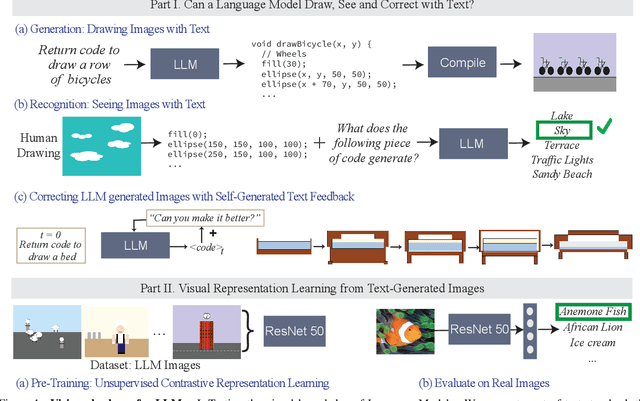
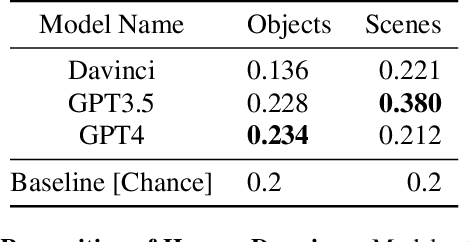
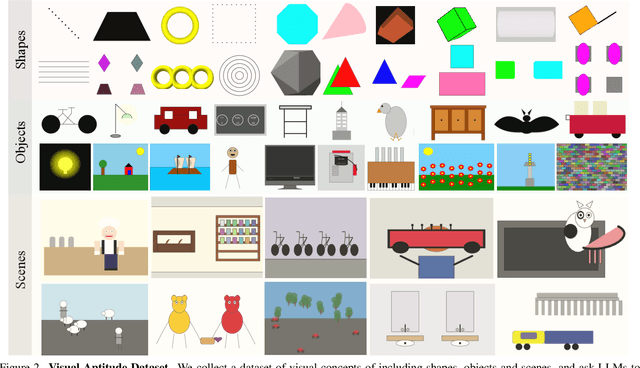
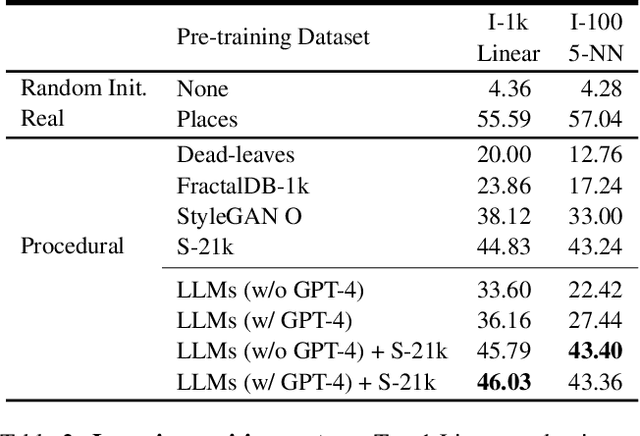
Abstract:What does learning to model relationships between strings teach large language models (LLMs) about the visual world? We systematically evaluate LLMs' abilities to generate and recognize an assortment of visual concepts of increasing complexity and then demonstrate how a preliminary visual representation learning system can be trained using models of text. As language models lack the ability to consume or output visual information as pixels, we use code to represent images in our study. Although LLM-generated images do not look like natural images, results on image generation and the ability of models to correct these generated images indicate that precise modeling of strings can teach language models about numerous aspects of the visual world. Furthermore, experiments on self-supervised visual representation learning, utilizing images generated with text models, highlight the potential to train vision models capable of making semantic assessments of natural images using just LLMs.
The Truth is in There: Improving Reasoning in Language Models with Layer-Selective Rank Reduction
Dec 21, 2023



Abstract:Transformer-based Large Language Models (LLMs) have become a fixture in modern machine learning. Correspondingly, significant resources are allocated towards research that aims to further advance this technology, typically resulting in models of increasing size that are trained on increasing amounts of data. This work, however, demonstrates the surprising result that it is often possible to significantly improve the performance of LLMs by selectively removing higher-order components of their weight matrices. This simple intervention, which we call LAyer-SElective Rank reduction (LASER), can be done on a model after training has completed, and requires no additional parameters or data. We show extensive experiments demonstrating the generality of this finding across language models and datasets, and provide in-depth analyses offering insights into both when LASER is effective and the mechanism by which it operates.
Learning adaptive planning representations with natural language guidance
Dec 13, 2023Abstract:Effective planning in the real world requires not only world knowledge, but the ability to leverage that knowledge to build the right representation of the task at hand. Decades of hierarchical planning techniques have used domain-specific temporal action abstractions to support efficient and accurate planning, almost always relying on human priors and domain knowledge to decompose hard tasks into smaller subproblems appropriate for a goal or set of goals. This paper describes Ada (Action Domain Acquisition), a framework for automatically constructing task-specific planning representations using task-general background knowledge from language models (LMs). Starting with a general-purpose hierarchical planner and a low-level goal-conditioned policy, Ada interactively learns a library of planner-compatible high-level action abstractions and low-level controllers adapted to a particular domain of planning tasks. On two language-guided interactive planning benchmarks (Mini Minecraft and ALFRED Household Tasks), Ada strongly outperforms other approaches that use LMs for sequential decision-making, offering more accurate plans and better generalization to complex tasks.
Pushdown Layers: Encoding Recursive Structure in Transformer Language Models
Oct 29, 2023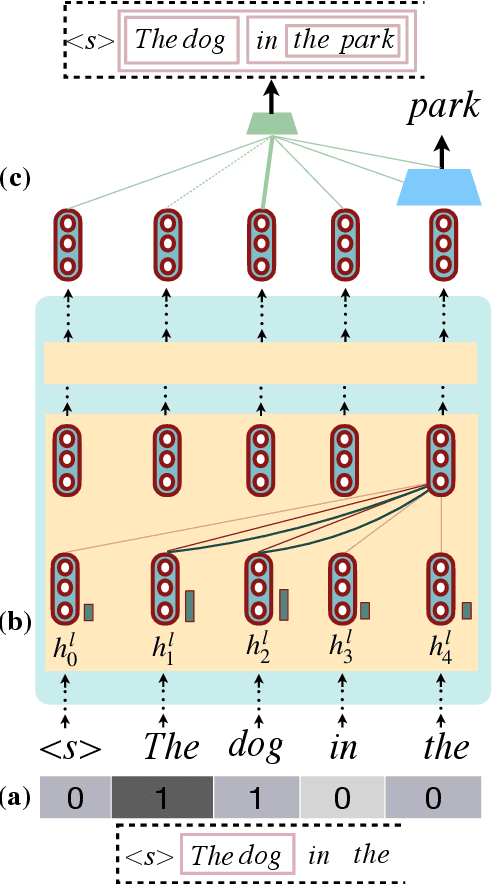
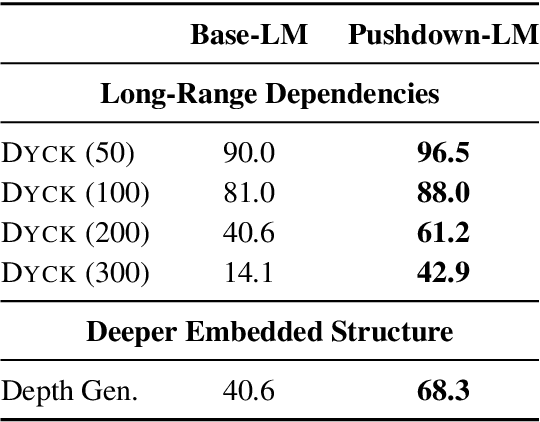
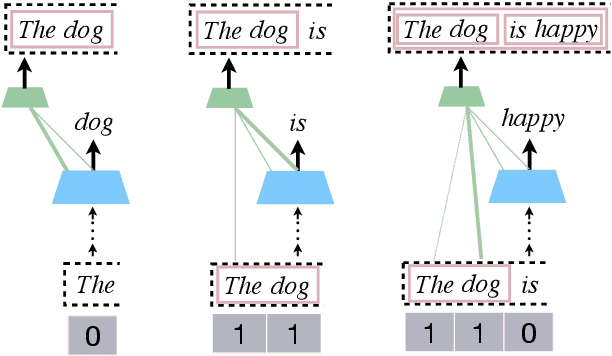
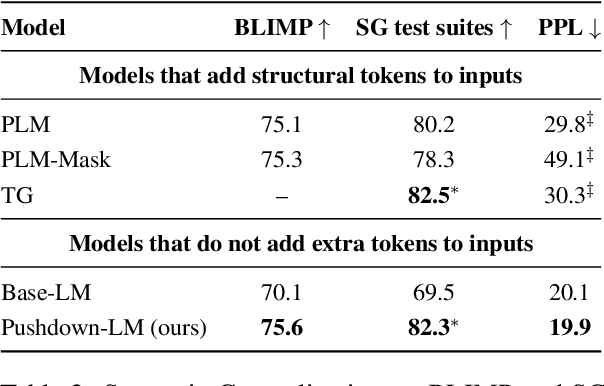
Abstract:Recursion is a prominent feature of human language, and fundamentally challenging for self-attention due to the lack of an explicit recursive-state tracking mechanism. Consequently, Transformer language models poorly capture long-tail recursive structure and exhibit sample-inefficient syntactic generalization. This work introduces Pushdown Layers, a new self-attention layer that models recursive state via a stack tape that tracks estimated depths of every token in an incremental parse of the observed prefix. Transformer LMs with Pushdown Layers are syntactic language models that autoregressively and synchronously update this stack tape as they predict new tokens, in turn using the stack tape to softly modulate attention over tokens -- for instance, learning to "skip" over closed constituents. When trained on a corpus of strings annotated with silver constituency parses, Transformers equipped with Pushdown Layers achieve dramatically better and 3-5x more sample-efficient syntactic generalization, while maintaining similar perplexities. Pushdown Layers are a drop-in replacement for standard self-attention. We illustrate this by finetuning GPT2-medium with Pushdown Layers on an automatically parsed WikiText-103, leading to improvements on several GLUE text classification tasks.
Pseudointelligence: A Unifying Framework for Language Model Evaluation
Oct 18, 2023Abstract:With large language models surpassing human performance on an increasing number of benchmarks, we must take a principled approach for targeted evaluation of model capabilities. Inspired by pseudorandomness, we propose pseudointelligence, which captures the maxim that "(perceived) intelligence lies in the eye of the beholder". That is, that claims of intelligence are meaningful only when their evaluator is taken into account. Concretely, we propose a complexity-theoretic framework of model evaluation cast as a dynamic interaction between a model and a learned evaluator. We demonstrate that this framework can be used to reason about two case studies in language model evaluation, as well as analyze existing evaluation methods.
Grokking of Hierarchical Structure in Vanilla Transformers
May 30, 2023Abstract:For humans, language production and comprehension is sensitive to the hierarchical structure of sentences. In natural language processing, past work has questioned how effectively neural sequence models like transformers capture this hierarchical structure when generalizing to structurally novel inputs. We show that transformer language models can learn to generalize hierarchically after training for extremely long periods -- far beyond the point when in-domain accuracy has saturated. We call this phenomenon \emph{structural grokking}. On multiple datasets, structural grokking exhibits inverted U-shaped scaling in model depth: intermediate-depth models generalize better than both very deep and very shallow transformers. When analyzing the relationship between model-internal properties and grokking, we find that optimal depth for grokking can be identified using the tree-structuredness metric of \citet{murty2023projections}. Overall, our work provides strong evidence that, with extended training, vanilla transformers discover and use hierarchical structure.
LaMPP: Language Models as Probabilistic Priors for Perception and Action
Feb 03, 2023



Abstract:Language models trained on large text corpora encode rich distributional information about real-world environments and action sequences. This information plays a crucial role in current approaches to language processing tasks like question answering and instruction generation. We describe how to leverage language models for *non-linguistic* perception and control tasks. Our approach casts labeling and decision-making as inference in probabilistic graphical models in which language models parameterize prior distributions over labels, decisions and parameters, making it possible to integrate uncertain observations and incomplete background knowledge in a principled way. Applied to semantic segmentation, household navigation, and activity recognition tasks, this approach improves predictions on rare, out-of-distribution, and structurally novel inputs.
 Add to Chrome
Add to Chrome Add to Firefox
Add to Firefox Add to Edge
Add to Edge